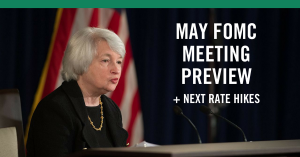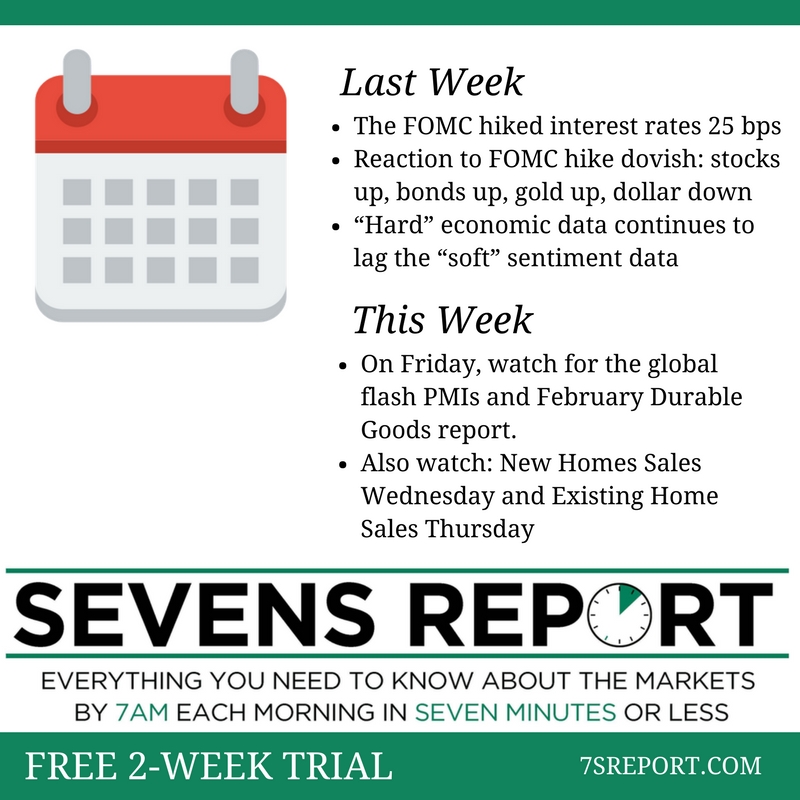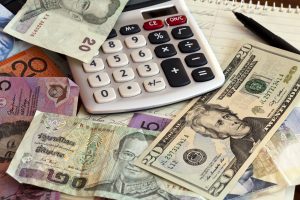FOMC Preview and the Next Rate Hike, May 2, 2017
Get the simple talking points you need to strengthen your client relationships with a free two-week trial of The Sevens Report.
There is virtually no chance the Fed will hike rates at tomorrow’s meeting, as the chances were slim before the recently disappointing economic data. Now, those chances have declined to near zero. The key question tomorrow is: Just how forcefully will the Fed telegraph the next rate hike?
The answer to that question, taken in the important context of the recent slowing of economic momentum, will decide whether the FOMC decision pushes stocks higher, or whether we see a retracement of the recent gains.

Hawkish If: The Fed clearly signals a rate hike is coming in June. Right now, Fed fund futures are pricing in about a 70% chance the Fed does hike rates, but that’s not a consensus expectation, yet. If the Fed specifically points to the “next” meeting in tomorrow’s statement (as it did in the fall of 2015 and 2016) as the likely date of the next rate increase, you will see markets react hawkishly as a June rate hike is not a foregone conclusion. Additionally, if the Fed is still intent on hiking rates in June despite recent economic data disappointments, that might imply a Fed that is more hawkish than previously expected.
Likely Market Reaction: Withheld for subscribers. Unlock with a free two-week trial of The Sevens Report.
Meets Expectations If: The Fed slightly downgrades the assessment of the economy in paragraphs one and two, but also says any slowing of activity is likely only temporary (it’s the temporary part that is the key). Markets expect the Fed to acknowledge the modest loss of economic momentum, but not to make too big a deal out of it.
Likely Market Reaction: Withheld for subscribers. Unlock with a free two-week trial of The Sevens Report.
Dovish If: The Fed materially downgrades economic commentary in paragraph one and downgrades the outlook on inflation, and in doing so materially reduces the chances for a June rate hike. Specifically, to be dovish we would need to see 1) A downgrade of both the growth and inflation language in paragraph one, plus no mention of it being temporary. The net effect would be to remove the expectation for a June rate hike.
Likely Market Reaction: Withheld for subscribers. Unlock with a free two-week trial of The Sevens Report.
Wildcard to Watch
Fed Balance Sheet. As we have covered, the reduction of the Fed’s balance sheet is an important but under reported topic that could result in a more-hawkish-than-anticipated Fed. Specifically, the major questions facing the Fed regarding the balance sheet are:
1) When will the Fed begin to reduce the balance sheet (2017 or 2018)?
2) What securities will the Fed stop buying (just Treasuries or Mortgage Backed Securities, too)?
3) How will the Fed stop reinvesting proceeds (all at once, or gradually)?
How these questions are answered will determine whether the Fed balance sheet is a hawkish influence on markets (yields up, stocks potentially down).
I (and almost everyone else) do not expect the Fed to touch on this in this week’s meeting. However, if the Fed does address this topic, it will come in paragraph five of the statement. Any change there will likely have hawkish implications on markets tomorrow, but again any changes are unlikely.
Join hundreds of advisors from huge brokerage firms like Morgan Stanley, Merrill Lynch, Wells Fargo Advisors, Raymond James and more… see if The Sevens Report is right for you with a free two-week trial.


